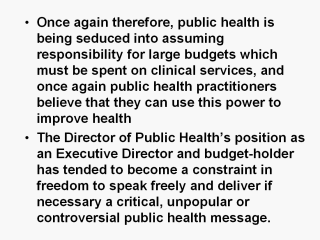| front |1 |2 |3 |4 |5 |6 |7 |8 |9 |10 |11 |12 |13 |14 |15 |16 |17 |18 |19 |20 |21 |22 |23 |24 |25 |26 |27 |review |
 |
Once again therefore,
public health is being seduced into assuming responsibility for large
budgets which must be spent on clinical services, and once again public
health practitioners believe that they can use this power to improve health.
Where this is linked to appropriate means of considering the total
expenditure and development of preventive, curative and rehabilitative
services, as for example in the Health Care Program developed by O’Brien and
his group for the Medical Royal Colleges, this is to be welcomed. Otherwise
there are obvious dangers. Thirdly, although public health is theoretically independent and capable of producing independent reports, it is inhibited by nature of the structure within which it works from enunciating and propagating messages contrary to the views of management or the employing health authority. This issue was covered previously by the special position of the Medical Officer of Health. Currently, the Director of Public Health’s position as an Executive Director and budget-holder has tended to become a constraint in freedom to speak freely and deliver if necessary a critical, unpopular or controversial public health message. The doctrine of the collective responsibility of the whole executive team can be an inhibiting factor in plain speaking. Although medically qualified consultant grade public health physicians have the same security of tenure that other consultants have, they are bound by similar rules of public disclosure. For DPHs to review progress and highlight deficiencies annually is a daunting task and for some an irreconcilable conflict between their roles as independent advisers and as members of executive teams with collective responsibilities. Even more subtle in its hostility is the relationship between the Director of Public Health and public health physicians and the Chief Executive of a Health Authority or Board. The salary of the Director of Public Health is based on a nationally agreed scale, that of the Chief Executive, and other non-medical senior staff, is assessed annually, and depends on a performance review which considers achievements in the past year against a set of agreed objectives. These are usually concerned with the development of services, financial control, waiting lists and other process measures. Chief Executives in Health Authorities are accountable to the Executive of the National Health Service, and will not wish to report any deterioration in the health services, the health status or the risk factors of their population. The Director of Public Health is a member of a corporate health authority team and will prefer not to undermine the Chief Executive. Thus, although in theory the Director of Public Health is free to publish an honest and if necessary critical Annual Report on the health of the local population or on deficiencies in particular services, there are many human and career factors working against complete candor. In the past 22 years service, public health practitioners have also had to reapply for their positions with each re-organization - that is, in 1974, 1981, and 1989 - and on other occasions when districts have been amalgamated or boundaries changed. This continuous turmoil and insecurity has not been conducive to the development of properly critical attitudes of the public health professional nor to the willingness of individual practitioners to speak out on issues of public health importance. |